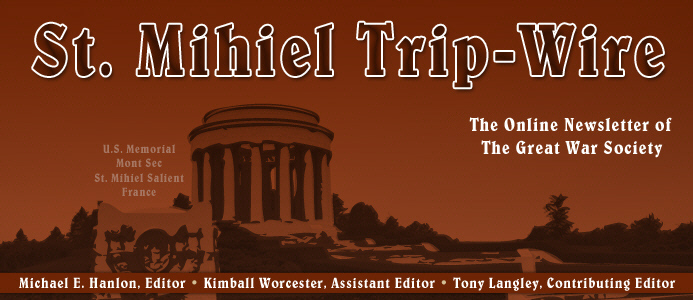

Special Field Report from the Western Front:
Our Annual World War I Battlefield Tour
TRENCH REPORT: We have had to publish few corrections in the history of the Trip-Wire, but here is one regarding our last issue. In my Field Report on the 65th Anniversary of D-Day, I stated that the last stop at the U.S. Omaha Beach Visitors Center features a GI field grave with a rifle stuck in the ground topped by a helmet and dog tags. As you can see on the photo to the right, there are no dog tags at the actual exhibit. It has been pointed out to me that a lot of people leave with the same impression, the hanging dog tags being part some collective memory. Well, that's still not an excuse for inaccurate reporting, so my apologies to the readers. . .My upcoming September has me scheduled to make two major trips, one to the National WFA-USA/TGWS Seminar in Kansas City and then, a few days later on to Turkey to lead my first ever tour group to the Gallipoli battlefields. Consequently, the next Trip-Wire will be a combined September/October issue. We will resume the normal schedule in November. MH
This Month's Internet Feature
Innovation During the Great War
Technology at War
Hap Arnold, Charles Kettering and "The Bug"
Greek Fire's Modern Guise: The Flamethrower
The Wrist Watch Routs the Pocket Watch
First Indian Code Talkers
Daylight Savings Time for Victory
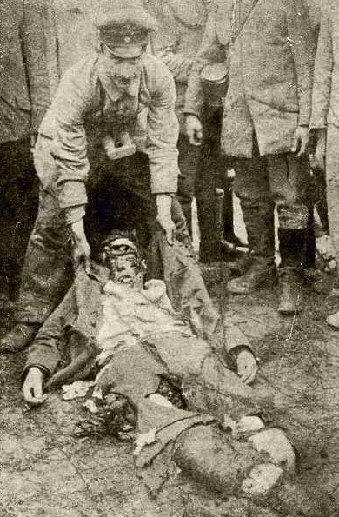 Someone's Son
New at Our Own & Our Friends' Great War Websites
Click on Title or Icon to Access
|
Recommended by Our Member Maj. Gen. Tom Jones
Excavating "Vampire" Tunnel, Ypres Salient
Featured in Archeology magazine
At Great War Society Sites
Help for WWI genealogical researchers at our expanded page:
At the WFA-USA
|

Just try to imagine an America without that wonderful delicacy Chicken Kiev. Alas, such a place once existed. The matter was corrected by White Russian émigré Col. Wladimir W. Yaschenko, formerly of the Tsar's Army and owner of the Yar Restaurant in Chicago in the 1930s. The Yar was very popular among the show business folk, who helped spread word through the vaudeville circuit about the "simply fabulous" stuffed chicken the colonel served.
|
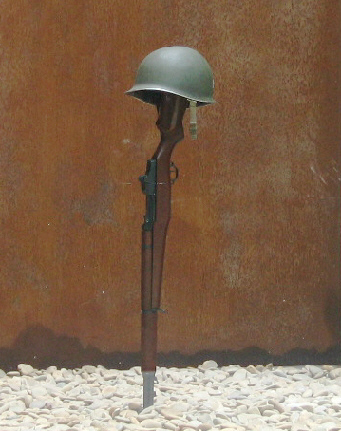
Final Exhibit at the Visitors Center at the
U.S. Omaha Beach Cemetery
(Courtesy American Battle Monuments Commission)
|
GREAT WAR 2009 EVENT CALENDAR
|
Western Front U.S.A. &
The Great War Society
Combined 2009 Annual Seminar,
September 11 - 13, 2009
National World War I Museum
Kansas City, Missouri
The and compelling theme for the seminar combines the original seminar ideas for both organizations: "Technology, Treaties and the War: From 'Tin Hats' to Tanks and 'Top Hats' to Territories." Registration forms, fees and further information will be forthcoming. Check back here or at the organizations' Websites for details. (link)
|
Back to the Cradle
League of WWI Aviation Historians
Biennial Seminar,
October 16 - 17, 2009
Double Tree Hotel at the Airport
San Antonio, Texas
Downloadble pdf document with details: (link)
|
Western Front Association
U.S. Branch Chapter Meetings
Check for Your Region
Regularly Updated (details)
|
Great War Society Monthly Chapter Meetings
Berkeley, San Francisco and Palo Alto, CA
Regularly Updated (details)
|
Upcoming Events at the National World War I Museum
Kansas City, Missouri
Regularly Updated (details)
|
Send additions/corrections:
Email Response
|
The International Society for First World War Studies has announced their 5th annual seminar for London on September 10-12, 2009. As in the past, however, they are accepting only members of their group as attendees. For more information: (link)
Late News Flash for New York Readers: On August 3, 2009, the Film Forum, located at 209 West Houston Street, between 6th Ave and Varick (7th Ave), will present three showings of the longer director's cut of the silent version of All Quiet on the Western Front. Check your local listings for the times.
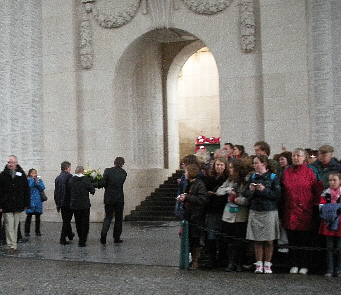
TGWS Member Jane Kimball at the Menin Gate
Our member Jane Kimball was a panelist in April at a Trench Art conference at the Flanders Fields Museum in Ypres. She was asked to lay a wreath on behalf of the group at the Last Post ceremony. Accompanying Jane are Andy Tonge and Nicholas Saunders. Photo by Judy Sunter.

In those days distance lent enchantment. For all its broke roofs and riddled gables, [St. Quentin] was fair to the eyes of the trench-bound soldier. When. . .in the autumn [of 1918] we came this way again, and St. Quentin fell, the city was a sorry picture of ruin and desolation.
From Goodbye to the Battlefields, Capt. H.A. Taylor,
Quoted in the Holt Guidebook The Western Front - South
|
|
|
|
|
Page Two
|
|
|
 |
Field Report: Spring 2009 Western Front Tour
By Trip-Wire Editor
Mike Hanlon |
In the spring, I led my fifth Western Front trip for Valor Tours of California. Because of the economy, it was a small group, but this allowed us to adjust the itinerary and take a few of Frost's "roads less traveled."
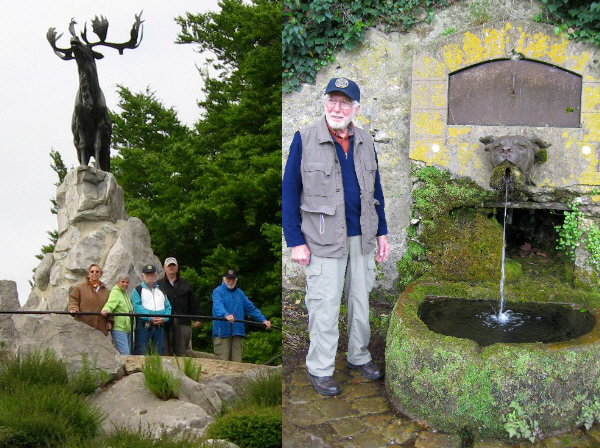
Naturally, we visited all the classic and legendary sites on the Western Front. Above we have some of the group at the Caribou Monument at Newfoundland Park on the Somme and on the right is Marine Andy Brown at the "Devil Dog" Fountain at the village of Belleau.
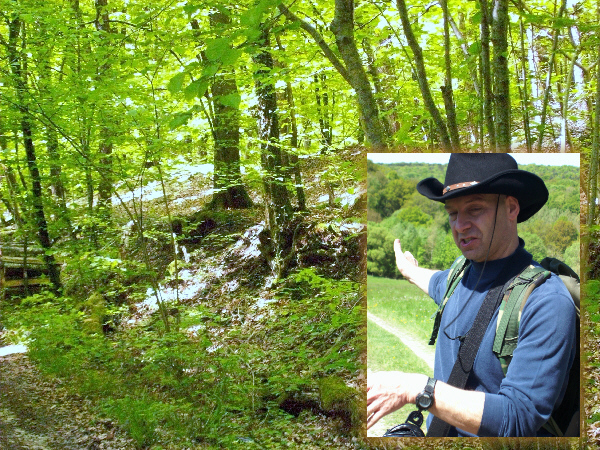
At the Sgt. York site in the Argonne Forest we luckily ran into Col. Doug Mastriano (insert), leader of the research team that has done such breakthrough work on the site. As always, Doug and his group very generous with their time showing us around their latest "digs."
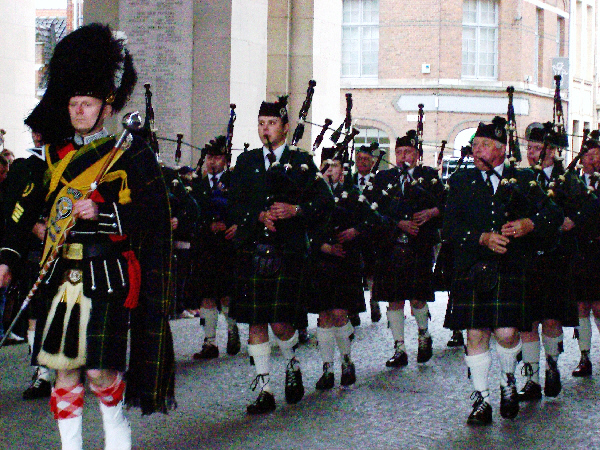
As I've written in past issues, the Last Post Ceremony at the Menin Gate, Ypres, is becoming a bit of an extravaganza. This year we had a full piper band enhancing what used to be a simple presentation.

For the first time, I was able to route one of my groups to the village of Souilly, south of Verdun. The town hall above was Petain's headquarters during the Battle of Verdun and of Pershing's First Army HQ during the St. Mihiel and Meuse-Argonne Offensives. The cameraman is standing on the Voie Sacrée.
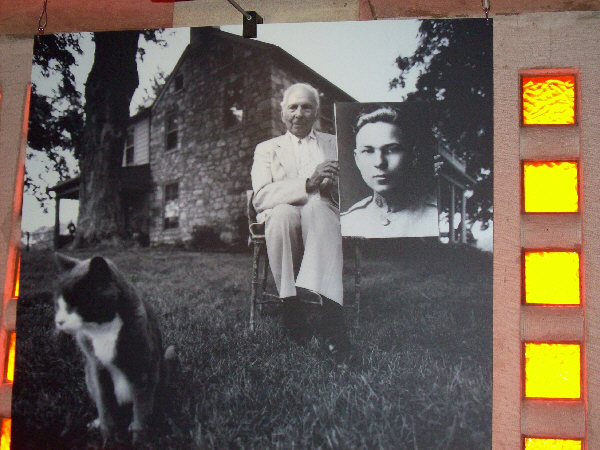
The biggest surprise on this year's trip came at the Verdun Ossuary--usually a very somber stop for our groups--which had a remarkable display of then and now (at least approximately now) photos of long-lived WWI veterans. Shown here is the panel for America's last Doughboy, Frank Buckles of West Virginia.

Next Year's Trip (Click on image to request a brochure)
|
|
World War I Headlines
in the
21st Century
|
|

95 Years Ago This Month
|
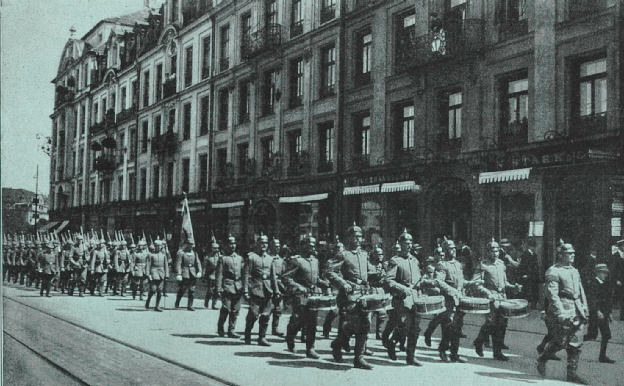
The 2nd Infantry Regiment Departs Munich for the Front
|
Click Here to Visit the Website of Our Contributing Editor Tony Langley
War in a Different Light
|
|
Subscribe to Our Online Magazine
|
|

|
|
|
Page Three
|
|
|
Sad news from the UK in July:
Henry Allingham, the world's oldest man and the oldest surviving British veteran from World War I, died at the age of 113 on July 18, 2009. Henry Allingham was a founding member of the modern Royal Air Force. The Guinness Book of World Records certified Allingham as the world's oldest man last month. Born in the East End of London during the reign of Queen Victoria, Allingham was brought up by his mother and grandparents. His father died when he was a baby. He joined the Royal Naval Air Service as an aircraft mechanic in 1915 after his mother died. Allingham was the last known survivor of the Battle of Jutland, considered the greatest battle of World War I. He was serving aboard the armed trawler HMT Kingfisher, which was sent to meet up with the British fleet as it fought the Germans off what is now mainland Denmark. (link)
Harry Patch, Britain's last survivor of the trenches of World War I, was a reluctant soldier who became a powerful eyewitness to the horror of war and a symbol of a lost generation. Patch, who died July 25th at 111, was wounded in 1917 at the Third Battle of Ypres near the Belgian village of Passchendaele, which he remembered as "mud, mud and more mud mixed together with blood." (link)
Former Royal Navy seaman Claude Choules is now the last surviving British veteran of the Great War (link).
|
|
 |
The Irish in Gallipoli
by Francis Ledwidge
|
Last month, we had a bit of verse from Irish poet Francis Ledwidge for our "Favorite Quote." I was struck by the day of his death near Ypres on July 31, 1917, the opening day of the Battle of Passchendaele. I did a little reading and learned that he had earlier served at Gallipoli in the action at Suvla Bay. Here another poem of his regarding that earlier campaign.
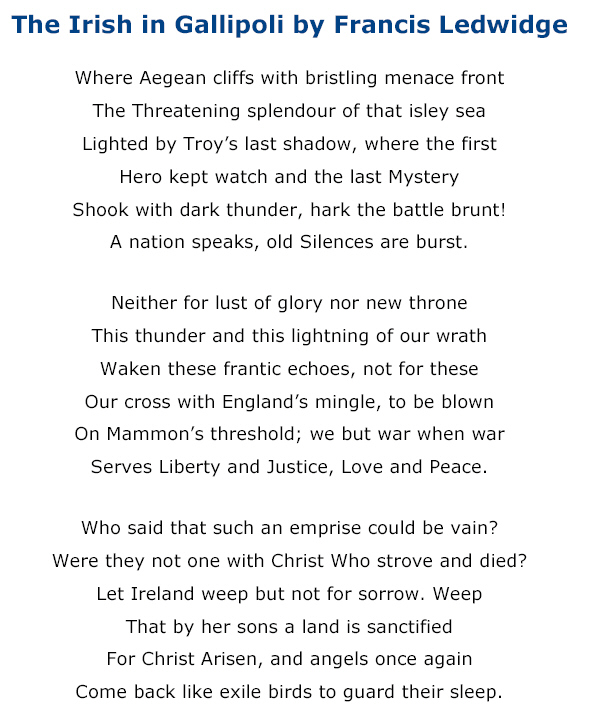
|
|
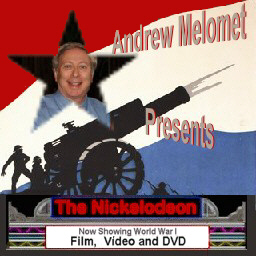 |
Aelita--Queen of Mars
Reviewed by Andrew Melomet
|
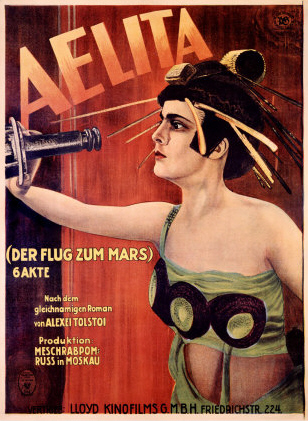
Her Majesty Aelita |
Always under state control, the Soviet film industry produced a number of very interesting science fiction films over the years. One of the earliest [and one that has some interesting connections to the First World War and the Russian Revolution] was Aelita-Queen of Mars (1924), based on a novel by Alexei Tolstoy, (distantly related to his more famous namesake.) Directed by Iakov Protazanov, Aelita is famous for its use of Constructivist [i.e. art for social purposes] sets by Isaak Rabinovich and its avant-garde costumes by Alexandra Ekster. Tolstoy wrote Aelita while an exile, hoping to return under favorable conditions. Asteroid 3771, Alexejtolstoj is named after him. A close reading of the original Aelita novella reveals a strong influence of the popular Martian novels written by Edgar Rice Burroughs.
The director, Iakov Protazanov (1881-1945) was considered the "Russian Griffith" and had been involved in making movies since 1907, but he had left Russia after the October Revolution to direct films in France for Gaumont and in Germany for UFA. Responding to a secret government campaign to persuade Russian artists to return to Russia, Protazanov came back to direct Aelita. This was a major propaganda coup for the Soviets, and Protazanov directed another nine silent films over the next six years, but none of the others had the scope and visual artistry of Aelita, which was one of the most expensive Russian silent films. His first sound film, Tommy (released in 1931), was the story of a British soldier's involvement with partisans.
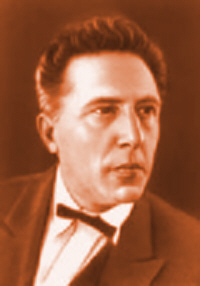
Iakov Protazanov |
Protazanov was the only major pre-revolutionary filmmaker to return to Russia, but as a "returned émigré" he always remained under suspicion for unseemly Western influence. Yet, somehow Protazanov, who was drafted in 1915, managed to survive the Great War, the 1917 Revolution, and evacuation to Yalta, self-imposed exile in France and Germany via Turkey, a return to Soviet Russia, the Cultural Revolution of 1928-30, the First Five Year Plan, Stalin's purges and show trials and the Second World War, when he evacuated to Alma Ata in the Urals during the German invasion of Russia.
In 1924 Mars was in favorable opposition (closest distance) to Earth. On August 23, 1924, "a day of national radio silence,' the U.S. Signal Corps reported that they were successful in receiving signals from Mars. According to Captain John P. Ferriter the signals "consisted in part of dashes of six seconds duration separated by intervals of seven seconds. These dashes were continued for several minutes, and were followed by a voice pronouncing words. They were isolated words of from one to four syllables." Unfortunately, not even the noted cryptologist William Friedman could decipher the reputed signals. During World War One, Friedman had served in France as General John J. Pershing's personal cryptologist, and during the 1920s he headed the Research and Development Division of MI-8, "America's Black Chamber."

Outdoor Set
An advertising campaign for Aelita ran in Pravda and Kinogazeta. Mysterious messages reminiscent of August's Mars signal appeared in Pravada--"ANTA. . .ODELI. . .UTA. . ." Kinogazeta published that "The signals are being received constantly by radio stations around the world--ANTA. . .ODELI. . .UTA. . .--have at last been deciphered! What do they mean? You will find out on 30 September at the Ars Cinema." At the premiere on September 30, 1924, the facade of the Ars Cinema in Moscow was decorated with giant Martian figures, illuminated columns and geometric shapes that reflected the unusual Constructivist sets and décor of the movie. The crowds at the premiere were so large that Protazanov, the film's director, couldn't get in.
Co-writer Alexei Faiko recalled that Protazanov was a perfectionist. "Work on the screenplay was neither fast nor smooth. Protazanov had all sorts of demands…always searching and striving for something new and more interesting."
Aelita begins in December 1921 during the last years of the Russian civil war and the first year of Lenin's quasi-capitalist economic plan, the NEP, New Economic Policy (1921-28). In a home-built space ship, Loss, an engineer dissatisfied with his domestic life, Gussev, a Bolshevik soldier, and Kravtsov, a private detective, fly to Mars and help the queen, Aelita, in a proletarian revolt against her father, King Tuskub. Aelita had previously fallen in love with Loss after viewing him on Earth through a long-range Martian telescope. Workers on Mars are so oppressed that when they're not needed they're frozen and placed in cold storage. Unfortunately, once the king is overthrown, Aelita intends to establish her own totalitarian regime.
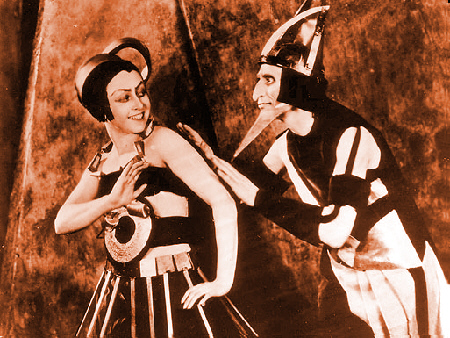
An Action Sequence Opens
Aelita's Constructivist set design show the influence of both French Cubism and Italian Futurism. Protazanov had experience of these movements from his years of living abroad, and Ekster had also maintained contacts with the Western avant-garde movement from before the Revolution. The Futurists were artists who felt that art should reflect the speed, violence, and chaotic noise of the 20th century. The set and costume designs influenced science fiction films for years to come, including Metropolis and Flash Gordon. Aelita's influence can even be seen as recently as 1990 in Guy Maddin's Archangel.
In 1924 the USSR was recovering from a civil war, a defensive war with White Russians, and a famine. Aelita was the first big-budget movie from Soviet Russia and utilized scarce metal resources in its production and set designs. Aelita was intended to compete with European and American movies and was very popular with its audiences (though less so with Soviet film critics); many children born that year were named Aelita.
Pravda wrote "The rising of the Martian workers has the stamp of the 'monumental' foreign films striving to convey quantity rather than quality." Izvestiya said "The mountain has produced a mouse." Kinonedelya (Cinema Week) said that the scriptwriters were individuals alien to the working class and advised that the Party keep bourgeois specialists like Protazanov under close watch.

Inside Set
The scenes set in contemporary Moscow provide a time capsule look of the city living under communism. There are refugees and ex-servicemen returned from the Civil War, fallen bourgeoisie, and the new professionals yearning for a new world. Loss's wife, Natasha, works at an overcrowded refugee checkpoint at the train station. The machinations of opportunistic black marketeers and Moscow's housing shortage are portrayed as commonplace. The film contrasts the grim (and occasionally comic) realities of modern Soviet life with life on Mars. European and American films of the same era would certainly have dressed up the earthbound characters and sets to make them more glamorous. Protazanov keeps his cast bundled up in heavy ungainly winter coats that look like they were brought in by the cast members from their own closets. Later in Aelita, once the NEP kicks in, the post-Civil War economic and social disorder is vastly improved.
Aelita-Queen of Mars was released on DVD in 1999 by Image Entertainment and is easily obtained online from Amazon.com or Deepdiscount.com.
Click here to download the 2004-2008 Index for the Nickelodeon
with Updates on Availability of Films and Videos in the U.S.
Check the Archives for 2009's reviews.
|
|























